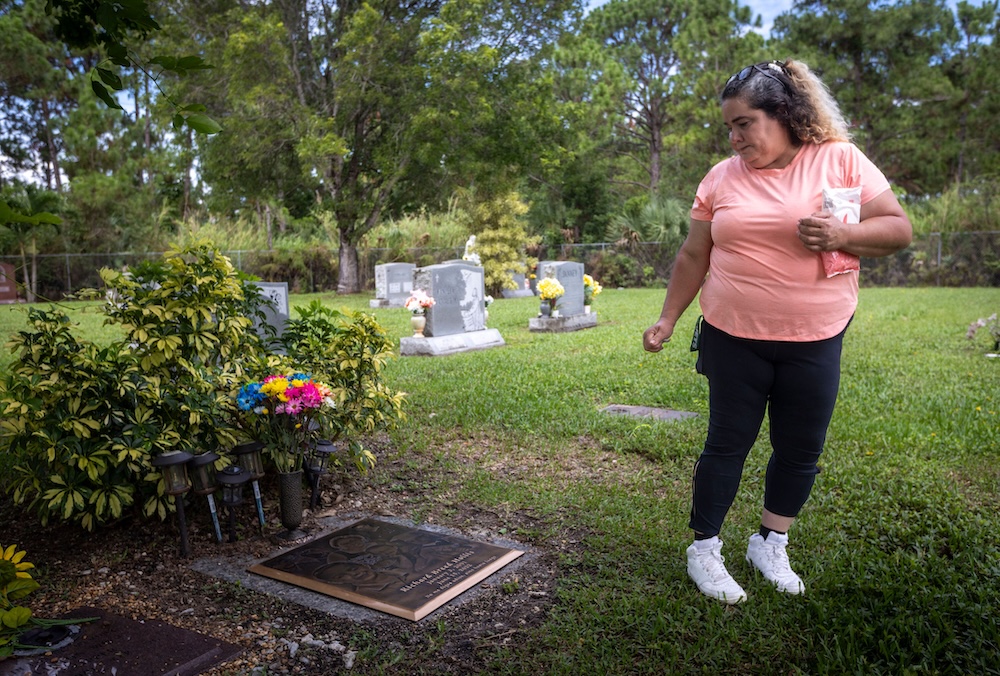“Life of the Mother,” a ProPublica series that revealed how state abortion bans in the U.S. have led to multiple preventable deaths, is the winner of the 2024 Taylor Family Award for Fairness in Journalism.
Reported by Kavitha Surana, Lizzie Presser and Cassandra Jaramillo with photography by Stacy Kranitz, the investigation uncovered the serious and sometimes fatal consequences of abortion restrictions that neither the federal government nor the states have tracked. “Life of the Mother” is also the winner of the Nieman Foundation’s 2024 Worth Bingham Prize for Investigative Journalism.
Judges also selected two finalists for the Taylor Award:
- “Guilty of Grief” is a Miami Herald investigation into the systemic failures that led to the killing of a mentally ill young man by a Miami-Dade police officer and the serous consequences for his grieving mother when she sought justice and answers. The series was reported by Carol Marbin Miller, Linda Robertson and Camellia Burris.
- “Coming to America” is an intimate profile of Palestinian teenager Layan Albaz, who traveled alone from Gaza to Chicago to receive vital medical care after losing her legs in an Israeli airstrike. The story was written by Rhana Natour, with photographs by Eman Mohammed.
The Taylor Award winner: ProPublica
When ProPublica set out to determine the effects of state abortion bans on maternal health after the Supreme Court’s reversal of Roe v. Wade, there was no roadmap to follow. No one knew the scope of the consequences because no one was compiling relevant statistics. Through their persistent efforts, ProPublica reporters Kavitha Surana, Lizzie Presser and Cassandra Jaramillo changed that.
In “Life of the Mother,” they scoured autopsy data and reports from medical examiners’ offices to show how state abortion bans in the U.S. have led to preventable deaths. They also worked to carefully balance the rights and privacy of sources, including grieving families and medical professionals, with the need to inform the public about an issue of national importance.
The series tells the stories of five women who died after they did not receive lifesaving medical care in states that have banned abortion. Three of the women who lived in Texas had miscarriages but didn’t receive the treatment they needed to survive. Two others in Georgia suffered fatal complications after they couldn’t access legal abortions in that state. Their stories also underscore the chilling effect that abortion bans have had on medical professionals who fear prosecution for providing treatment that could be deemed illegal.
Surana and photojournalist Stacy Kranitz also spent a year documenting the life of Mayron Hollis, a woman who struggled with serious personal issues and was forced to continue a life-threatening pregnancy in Tennessee, a state that had banned abortion yet offers little post-natal support. Special care was taken to ensure Hollis’ voluntary and informed consent, given the potential consequences of her story being shared publicly.
“Life of the Mother” has had far-reaching impact. Among important changes resulting from the series:
- ProPublica’s reporting was mentioned in a September 2024 resolution introduced by dozens of U.S. senators calling on hospitals to provide emergency abortion care when patients needed it. A companion resolution was introduced in the U.S. House of Representatives one week later.
- Sen. Ron Wyden of Oregon, chair of the U.S. Senate Finance Committee cited ProPublica’s reporting on one of the death’s in Georgia hospital when he opened an investigation that showed how hospitals have been “conspicuously and deliberately silent” in the face of abortion bans, with doctors given little guidance on how to treat emergency patients with pregnancy complications.
- In January 2025, ProPublica reported that lawmakers in at least seven states were seeking expanded abortion access, with some of the bills filed in direct response to ProPublica’s reporting.
- In Texas, a bill was introduced to direct the state’s maternal mortality review committee to examine cases in which women died after miscarriages or because they could not access procedures to end pregnancies; the state currently restricts the committee from looking at cases in any way associated with abortion procedures.
- In March 2025, Republican lawmakers in Texas proposed amending the abortion ban linked to maternal deaths and a rise in sepsis cases to make it clear that doctors can terminate pregnancies without having to wait until a patient’s condition becomes life-threatening. The new legislation came after 111 Texas doctors, citing ProPublica’s reporting, signed a public letter urging that the ban be changed because it restricted their ability to do their work.
Taylor Award judge Sally Buzbee praised the reporting saying: “This was an amazing body of work that was able to get at a question that no government agency or other institution seemed able or equipped or interested in documenting: whether the web of confusion and physician/hospital caution around restrictive new state abortion laws was leading to the deaths of women. ProPublica nailed that these new laws had indeed resulted in deaths. That was critical reporting on a topic of utmost importance, timeliness and relevance and it provided critical accountability and fairness to the women and their families. Importantly, ProPublica also modeled for other news organizations how to report on these complex questions of health and ascertain what was truly caused by the laws.”
Taylor Award judge Joe Mahr added: “In delving into perhaps the most contentious topic of modern times, this series required not just dogged reporting and deft storytelling but also extreme care in navigating thorny questions of whose stories were told and how they were told. The submission details how the reporters decided to omit stories when relatives declined to talk to reporters and how they worked through one source’s fears of retribution. And in the writing process, the choices of doctors were contextualized, not demonized, so readers could best assess the effects of one of the most consequential changes in public policy this century — and one the reporters could demonstrate had led to tragic deaths.”
Taylor Award Finalists

“Guilty of Grief” (The Miami Herald)
The Miami Herald’s “Guilty of Grief” investigation used a combination of longform narrative and police body-camera footage to explain what led Miami-Dade Police Officer Jaime Pino to shoot and kill 21-year-old mentally ill Richard Hollis — and why his mother, Gamaly Hollis, wound up in jail for a year after publicly lashing out at Pino.
Told in four chapters by reporters Carol Marbin Miller, Linda Robertson and Camellia Burris, the series revealed a host of problems that had contributed to Richard Hollis’ death, including Florida’s deficient mental health care system and a police force poorly trained to handle cases involving mentally ill people. Its innovative use of raw body-cam footage to tell the story let viewers see for themselves what had unfolded in real time, an important component of a story that involved complex and flawed subjects.
The reporters combed through hours of police footage, 2,000 pages of Richard Hollis’ medical and civil commitment records, police reports, 911 calls, court records, and trial transcripts to tell the story fairly. They interviewed Gamaly Hollis, her neighbors and mental health, police and domestic violence experts to reveal the broad scope of the problems involved. And they grappled with the ethics of publicly exposing Richard’s mental health struggles, doing so only after consulting with his mother and lawyers involved in her case.
One week after the series was published, prosecutors who had threatened to send Gamaly Hollis back to jail announced that they instead would offer Gamaly probation deal. She rejected the offer, saying she still wants answers, and is currently awaiting trial. Also in response to the reporting, Miami-Dade Public Defender Carlos Martinez has announced a new initiative in to convene a working group will meet monthly to oversee use-of-force incidents involving people with mental illness. The public defender’s office additionally hired Thompson Reuters to begin an AI-assisted investigation of hundreds of police reports involving use of force.
The team that produced “Guilty of Grief” comprised reporter and deputy editor Carol Marbin Miller, senior reporter Linda Robertson, Esserman investigative reporting fellow Camellia Burris, photographer Jose Iglesias and McClatchy News data/visual journalist Susan Merriam.
Taylor Award judge Maurice commented: “This operatic series takes clear pains to avoid unfairly stigmatizing its principal characters, as they both make poor choices and play out the repercussions of policy choices they did not make. I’ve read lots of investigative stories about similar deaths amid our broken mental health system, but this one felt like it went beyond the usual tropes of the genre to help the reader digest the complex links between policy messes and intimate family tragedies.”
“Coming to America” (The Atavist Magazine)

With heart and candor, “Coming to America” tells the story of Palestinian teenager Layan Albaz and her physical and emotional journey from Gaza to Chicago for medical care for life-altering injuries and from devastating loss to resilience and healing.
Reported by Rhana Natour with photographs by Eman Mohammed, the story personalizes the grim realities faced by thousands of Gazans — many of them children — who have lost limbs and suffered other injuries and trauma in the war that has ravaged their lives and communities for the past year and a half.
Layan, who in quick succession lost her home and her best friend, was gravely injured in an October 2023 Israeli air strike in that also killed two of her sisters, a newborn nephew and a niece. She fell six stories in the attack and sustained injuries so severe that doctors amputated both of her legs, which was done without anesthesia. Unable to receive proper care in Gaza’s shattered healthcare system, she traveled alone via Egypt to Chicago, sponsored by the NGO HEAL Palestine, one of only a handful of Palestinian children evacuated to the United States for medical treatment.
Natour and Mohammad followed Layan as she adapted to life far away from family and friends and to intense physical rehabilitation and new prostheses at Shriners Children’s Chicago, a hospital specializing in pediatric orthopedics. The journalists took care to respect boundaries while offering a frank portrayal of a 14-year-old coming to grips with a life forever changed. The article also explored the difficulty of obtaining accurate and current statistics on war injuries in Gaza.
In addition to Natour and Mohammed, the team that produced “Coming to America” includes Atavist editor-in-chief Seyward Darby, art director Ed Johnson, copy editor Sean Cooper, fact-checker Lila Hassan and translator Ammar Owaineh.
In August 2024, Layan was able to greet Khalil, a 14-year-old boy who, like her, lost both of his legs in Gaza, at Chicago O’Hare International Airport. Walking on her new prosthetic legs, she welcomed him and his family. Layan is also now attending school with the children of her host family.
Taylor Award judge Megan Crepeau said: “It is hard to fully comprehend the scale of the destruction in Gaza. But this piece is so effective because it examines the war with a telescope and a microscope, putting Layan’s individual struggle in broader context. This could so easily have been maudlin and two-dimensional, painting her as a simple avatar of victimhood. Instead, Layan is written with precision and deep care. The writer’s commitment to working with her and her host family shows a real respect for fairness.”
“Coming to America” was also published in Arabic.
The journalists who judged the 2024 Taylor Award competition are Megan Crepeau, Chicago correspondent at Bloomberg Law and Joe Mahr, investigative reporter for the Chicago Tribune, who together were winners of the 2023 Taylor Award for their Chicago Tribune investigation “Stalled Justice”; Maurice Chammah, staff writer for The Marshall Project and a 2023 Taylor Award finalist; Darryl Fears, independent writer, researcher and reporter and a 2023 Nieman Fellow; Sally Buzbee, U.S.-Canada editor at Reuters and a 2024 Visiting Nieman Fellow.
The Taylor Award is presented by the Nieman Foundation for Journalism at Harvard. The honor includes a $10,000 prize for the winner and $1,000 each for the two finalists. The award program was established through an endowment by members of the Taylor family, who published The Boston Globe from 1872 to 1999. The purpose of the award is to encourage fairness in news coverage by American journalists and news organizations.
The Nieman Foundation for Journalism at Harvard educates leaders in journalism, promotes innovation and elevates the standards of the profession. More than 1,700 journalists from 100 countries have been awarded Nieman Fellowships since 1938. The foundation also publishes Nieman Reports, a website and print magazine covering thought leadership in journalism; Nieman Journalism Lab, a website reporting on the future of news, innovation and best practices in the digital media age; and Nieman Storyboard, a website showcasing exceptional narrative journalism and nonfiction storytelling.



